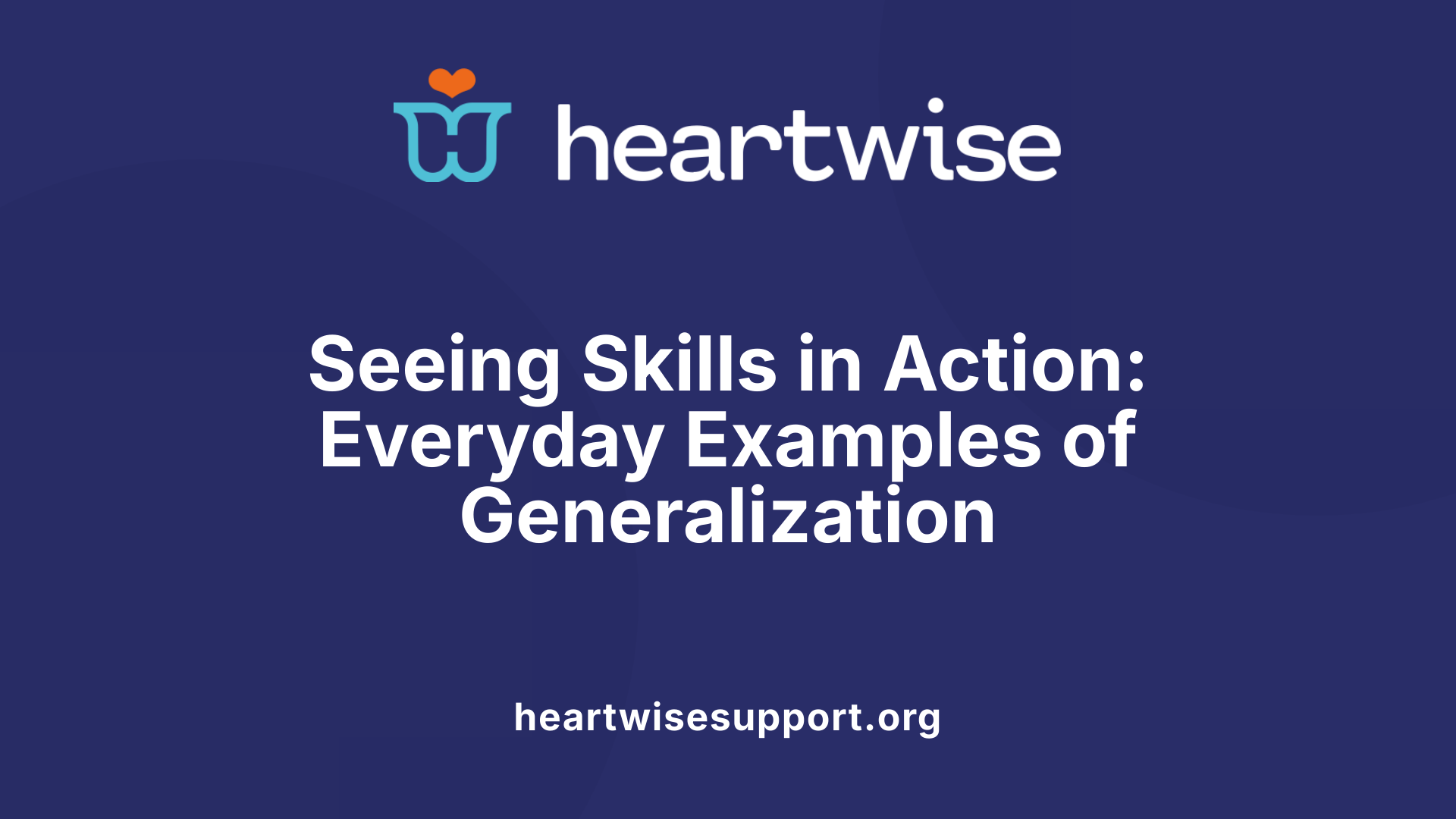Understanding Skill Generalization in ABA
Applied Behavior Analysis (ABA) is a widely recognized therapeutic approach for children with autism spectrum disorder (ASD). A core component of ABA’s effectiveness lies in skill generalization—the ability to transfer learned skills to various settings, people, and situations. This article explores how ABA promotes skill generalization, the importance of this process, strategies to enhance it, and the challenges involved, all with the aim of fostering meaningful, functional skills that support independence in everyday life.
Defining Skill Generalization in ABA

What is skill generalization in ABA therapy?
Skill generalization in ABA therapy is the process by which children with autism apply the skills they learn in therapy to other areas of their lives. It means that a behavior learned in one setting, such as a therapy session, transfers to different environments like home, school, or community activities.
There are two main types of generalization:
- Stimulus generalization: This occurs when a child responds similarly to different stimuli. For example, if a child learns to say "hello" to their teacher and then also greets a neighbor in the same way, they are demonstrating stimulus generalization.
- Response generalization: This happens when a child uses different but related responses for the same purpose. For instance, if a child learns to ask for help using various phrases like "Can you help me?" or "I need assistance," they are showing response generalization.
The primary goal of generalization in ABA is to help children become more independent by using their skills across all settings they encounter daily. It ensures that what they learn in therapy is not limited to a specific situation but becomes a part of their everyday life.
To foster this transfer of skills, therapists incorporate teaching strategies such as practicing in multiple environments, involving caregivers, varying instructions, and gradually reducing prompts. This comprehensive approach helps children develop meaningful and functional behaviors that support their independence.
In summary, skill generalization in ABA has a significant impact on achieving long-term success. It allows children to use newly acquired skills seamlessly across different settings and helps them navigate the world more confidently and independently.
Why Skill Generalization Matters in ABA

Why is skill generalization important in ABA intervention?
Skill generalization is a fundamental component of effective Applied Behavior Analysis (ABA) therapy. It ensures that the skills children acquire during therapy are not limited to clinical or specific teaching environments but extend into everyday settings such as home, school, and community. This transferability is vital for enabling children to function independently and confidently in real-world situations.
When children can demonstrate skills across various environments and with different people, they are more likely to experience meaningful progress. For example, a child who learns to greet others in therapy will need to generalize this behavior to new scenarios, such as greeting a teacher at school or a neighbor in the neighborhood.
Strategies used by ABA therapists to promote generalization include teaching in multiple settings, involving caregivers, varying instructional cues, and gradually reducing prompts. Such approaches help the child adapt learned behaviors to diverse situations, fostering independence.
Collaborating with parents and caregivers also plays a crucial role. When they reinforce skills at home and encourage practice across different contexts, maintaining progress becomes easier.
Ultimately, effective generalization in ABA leads to more durable and functional skill development. It helps children rely less on structured teaching and more on independently applying skills in their daily lives, translating therapy gains into real-world success.
| Types of Generalization | Description | Examples |
|---|---|---|
| Stimulus Generalization | Responding similarly to different stimuli | Saying 'Hello' to different people |
| Response Generalization | Using different but related behaviors for the same goal | Asking for a preferred item in various ways |
| Maintenance | Retaining and using skills over time | Continuing to use a hand-raising gesture weeks after training |
Fostering each of these types supports long-term progress. By promoting variability and involving natural routines, ABA therapists and caregivers can improve the likelihood that children will successfully transfer and sustain their skills in everyday life.
Strategies for Effective Skill Generalization

What are effective strategies used in ABA to promote skill generalization?
Promoting skill generalization is a central goal in Autism Behavior Analysis (ABA) therapy, ensuring that children can transfer learned skills to various real-world contexts. Several practical strategies are employed by therapists to achieve this.
Firstly, therapists teach skills across multiple environments and involve different persons. This could include practicing skills at home, in school, and within community settings, with caregivers, teachers, and peers. Such diverse teaching environments encourage children to apply skills broadly.
Incorporating variability through naturalistic teaching methods enhances this process. Natural Environment Training (NET), for example, exposes children to real-life situations where they can apply new skills, making learning more meaningful and durable.
Modeling and prompting are also vital. Therapists demonstrate behaviors through in-vivo or video modeling, which show the child how to perform certain skills in various settings. Prompting techniques support the child in executing behaviors correctly, and gradually fading prompts fosters independence and promotes transfer.
Involving caregivers and natural supports is a critical component. Educating parents and teachers on reinforcement strategies, visual supports, and consistent routines helps reinforce skills outside therapy sessions. This ongoing reinforcement aids in long-term skill maintenance.
Summary table of strategies:
| Strategy | Description | Impact |
|---|---|---|
| Multiple environments | Teaching skills in various settings | Promotes environmental transfer |
| Variability in instruction | Using diverse stimuli and responses | Broadens effective response range |
| Modeling techniques | Demonstrating skills with videos or live | Supports skill acquisition and transfer |
| Caregiver involvement | Training caregivers to reinforce | Ensures consistency and maintenance |
Overall, combining these approaches creates a robust framework that facilitates the generalization of skills. Consistent practice across different contexts helps children with autism to function more independently and confidently in their daily lives.
Overcoming Challenges in Skill Generalization

What challenges can arise in achieving skill generalization, and how can they be addressed?
In ABA therapy, children with autism may face several hurdles when it comes to applying their learned skills across different settings and situations.
One common obstacle is the difficulty in transferring skills from the structured therapy environment to more natural settings like home or school. Variations in stimuli, cues, and social contexts can make it hard for children to recognize when and where to use their skills.
Inconsistent reinforcement is another challenge, where caregivers or peers may not always respond to or reinforce the child’s behavior, making it less likely to be retained and used outside therapy.
Limited practice across diverse environments can also hinder generalization because children might only perform skills in specific, familiar settings.
To address these challenges, therapists emphasize teaching skills in multiple environments and involving caregivers and peers in the process. This helps children see the relevance and application of their skills in everyday life.
Strategies such as varying stimuli—using different people, settings, and materials—can promote flexibility in responding. Modeling appropriate behavior, encouraging peer interactions, and gradually fading prompts are also effective methods.
Caregiver involvement is especially vital. Training parents and teachers to reinforce skills consistently and appropriately ensures that children receive continuous support outside therapy.
Additionally, creating structured generalization plans that specify how and when to practice new skills across different contexts can guide caregivers and educators.
By combining these approaches, children with autism are more likely to transfer and maintain skills across various environments, fostering greater independence and success in real-world situations.
Real-Life Examples of Skill Generalization
 Generalization plays a vital role in helping children with autism apply their skills across different everyday contexts, leading to greater independence. For instance, a child who learns to ask for a snack during therapy may then use words or gestures to request food at home, from grandparents, or at school. This ability to transfer the skill enables the child to access desired items in various settings without needing separate instructions.
Generalization plays a vital role in helping children with autism apply their skills across different everyday contexts, leading to greater independence. For instance, a child who learns to ask for a snack during therapy may then use words or gestures to request food at home, from grandparents, or at school. This ability to transfer the skill enables the child to access desired items in various settings without needing separate instructions.
Daily life examples demonstrating generalization include turning on lights in different rooms using various methods, such as flipping switches or using remote controls. Dressing skills, like fastening jackets with zippers or snaps, are performed smoothly across different clothing types. Opening doors with different handles or locks illustrates response generalization across environments.
In social interactions, a child learning to greet others by saying 'Hello' can generalize this greeting to classmates, teachers, and neighbors. They might also adapt their responses based on the situation, such as giving a high-five instead of a verbal greeting with friends.
Such behaviors directly influence independence. When children can transfer skills like navigating environments, communicating needs, or performing daily routines across different settings, they become more capable of functioning independently in real-world situations.
This ability to generalize skills helps reduce frustration and increases confidence, making it easier to participate in community activities, attend school, and enjoy social interactions. Promoting generalization in therapy ensures that gains achieved in controlled settings translate into meaningful, everyday functioning for children with ASD.
Supporting Neurodiverse Children Through ABA
How does ABA facilitate learning and adaptability in neurodivergent children?
Applied Behavior Analysis (ABA) plays a crucial role in helping neurodivergent children develop essential skills and adapt across various contexts. It employs evidence-based techniques such as modeling, prompting, reinforcement, and systematic teaching strategies to promote learning.
A significant focus of modern ABA approaches is respecting each child's unique communication styles, social behaviors, and sensory preferences. Instead of enforcing conformity, these methods aim to enhance the child's quality of life, fostering independence and self-advocacy.
One way ABA supports adaptability is through the understanding of generalization. This process involves teaching skills in controlled settings and then helping children transfer these skills to new environments, different people, and varied situations. For example, a child who learns to greet their teacher appropriately can then generalize this behavior to family members or peers.
In addition, naturalistic and developmentally appropriate interventions are integrated into ABA to promote social communication and flexibility. These methods involve engaging children in activities that are meaningful to them within regular routines, which enhances motivation and relevance.
Addressing sensory and emotional needs is another critical component. Techniques that foster self-regulation help children manage sensory overload and emotional responses, further enabling them to engage and adapt in diverse situations.
Overall, contemporary ABA approaches are designed to support the diverse needs of neurodivergent children. By combining structured skill-building with respect for individual differences, these methods empower children to become more autonomous and capable of navigating their environments successfully.
The Path to Practical, Lasting Skills
In summary, skill generalization is a fundamental aspect of effective ABA therapy, ensuring that children with autism and other neurodivergent conditions can apply their learned skills across diverse, real-world contexts. Through strategic teaching, modeling, involving families, and addressing challenges, ABA practitioners can foster independence and adaptive functioning. Recognizing the importance of generalization not only enhances the long-term success of intervention but also empowers children to navigate their environments more confidently, ultimately leading to greater autonomy and improved quality of life.
References
- Training and generalization of affective behavior displayed by youth ...
- What is generalization in ABA therapy? - Nevada Autism Center
- Generalization in ABA Therapy for Skill Expansion
- Understanding Generalization of Skills in ABA Therapy
- What is Generalization in ABA?
- What is generalization in ABA therapy? - Nevada Autism Center
- What is Generalization in ABA?
- Understanding Generalization of Skills in ABA Therapy
- 5 Powerful Generalization ABA Examples You Need to Know
- Generalization in ABA Therapy for Skill Expansion











